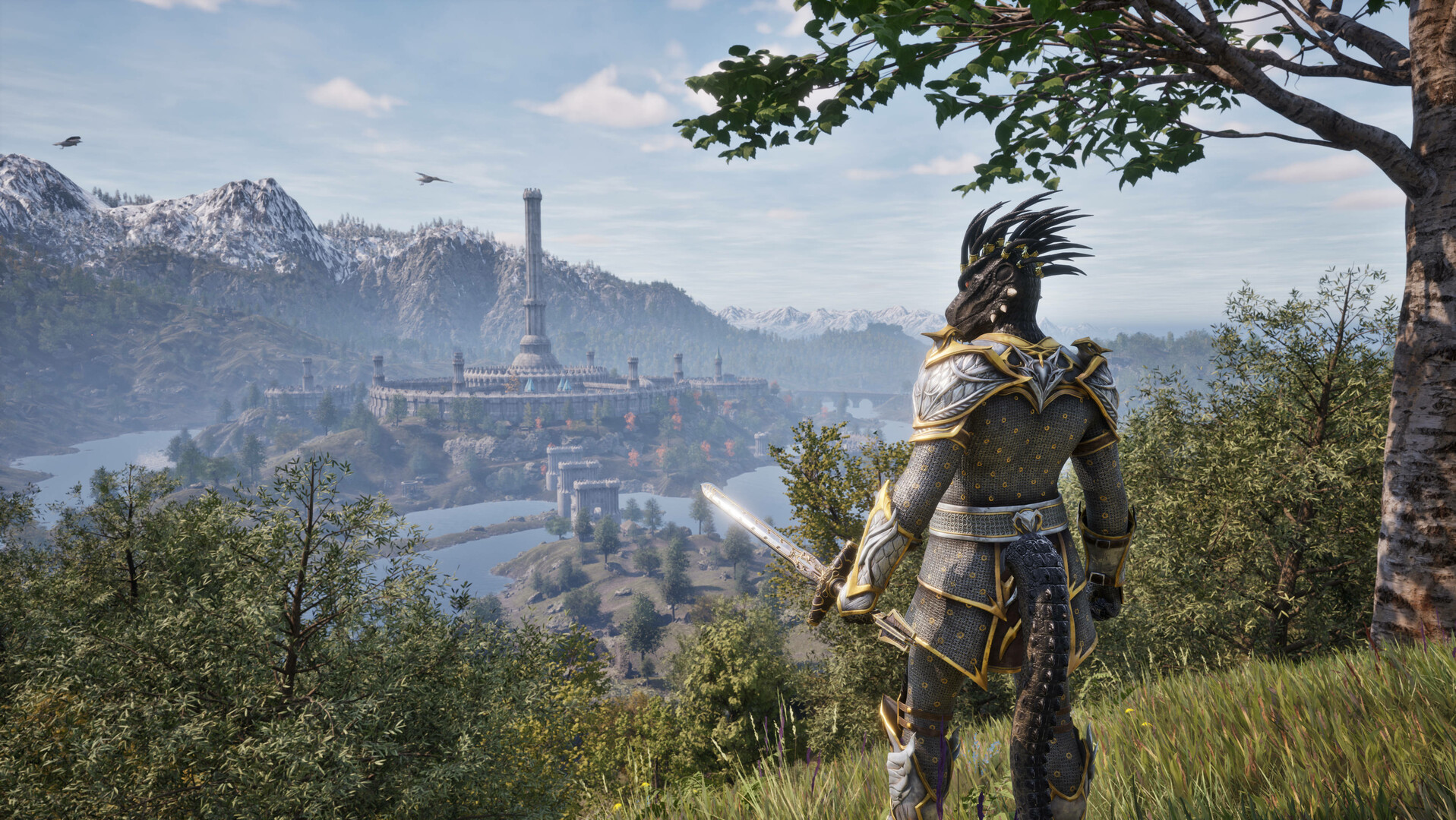Platforms:
PC, PS5, Xbox Series X|S
Released:
April 22, 2025
Publisher:
Bethesda Softworks
Developers:
Virtuos, Bethesda Game Studios
In 2006, Bethesda Studios released The Elder Scrolls IV: Oblivion, an ambitious and widely adored first-person fantasy RPG that further cemented the company as a beloved Western RPG developer. Featuring a vast open world where it felt like the sky was the limit, it captured people across the globe. 19 years later, and we have the re-release with new embellishments in The Elder Scrolls IV: Oblivion Remastered. Remaining simultaneously a product of its time and reflection of the highs and lows for the studio that have come since, it feels pretty damn good to return to the world of Cyrodil… even if that comes with some caveats.
Following the assassination of Cyrodil’s Emperor, the land is set into unrest when this results in Oblivion Gates opening across the world, portals to an otherworldly hell where demons and the like seep through. Sending the otherwise relatively peaceful medieval land into disarray, you, a wanderer pardoned for your crimes, inadvertently join the plight for a better Cyrodil. Closing gates, staving off enemy threats and finding alliances in big and small places… your vast journey is largely the same as it ever was. You will work through the main story (something that frankly was never Bethesda’s strong suit and remains so here), all in the hopes of being crowned the Champion of Cyrodil. Of course, that’s only half the fun.
What caused The Elder Scrolls IV: Oblivion to net so much acclaim back in the day was the colossal open world and bounty of opportunities: choosing if you want to be a Wood Elf Archer or maybe an Argonian Mage, for example. You could choose whether you wanted to prioritise your time banding up with the Thieves Guild or the assassin clan known as the Dark Brotherhood. Possibilities felt endless back in the day, and though they seem more limited in hindsight thanks to the years that’ve come since, the magic is mostly still there.
There is little more quintessential to me in video games than being a guy in a fantasy setting, creeping through a cave and taking on a series of smaller goblin guys, beasties and creepy crawlies. It’s a sensation and level of immersion and exploration I’ll never grow tired of. Skyrim was my first foray into the series upon its release, and though I’m entirely new to Cyrodil, I was scratching those same itches of a first-person fantasy RPG that I rarely get these days. I got similar feelings recently in Kingdom Come: Deliverance II, and it’s exciting to keep that ball rolling and the good times going.

It’s good, then, that The Elder Scrolls IV: Oblivion Remastered follows suit from both its series sequel and genre innovation with its fine-tuning and additions. There’s more flavour text throughout the world; HUD and UI are a lot cleaner and on par with more modern games to help orient and immerse the player. Character ‘origins’ now are a new skin for how each race gets some predetermined skills. Crucially, levelling is a lot clearer as it allows you to note how far into a skill’s level you are with a progress bar, also including more specialisation options with the Virtue Points that let you add a set number of points to 3 skills at a time. It’s a healthy upgrade that makes this 16-year-old charming hunk of junk play just that little bit better.
Cyrodil feels a lot smaller in hindsight, and movement around the map doesn’t take all that long. The plot’s fairly linear and can be wrapped up quite quickly; I even incidentally completed a solid third of the campaign just by casually exploring as a newcomer to the world. All of this is to say that it’s very humbling how less intimidating a beast Oblivion is today. It can be a several hundred-hour-long epic if you scour and do everything, clearing out every cave, getting your own house and checking the many quests off your list. Kick down a door and catch me mid-gameplay binge haze, and you’d probably find me doing what I normally do in these games: lockpicking houses, looting, using exploits to my advantage and getting into a boatload of trouble. Thankfully, the moment-to-moment gameplay shines even when you’re not getting the water-cooler style gameplay moments of a dragon attack at a random moment’s notice that its successor had.

The Elder Scrolls IV: Oblivion Remastered was handled by Virtuous and is essentially the original game with its DLC and an Unreal Engine 5 fixing and coat of paint. The reason I’d hesitate to call this remaster premium and praise it to the level of other remaster-bordering-on-remake titles is that it will pale when held up to comparisons simply due to the remaining warts and oddities that remain. These will, of course, bother you exponentially or not even remotely, depending on how seasoned a Bethesda Studios player you are. Throw into the fact that it’s also twenty-year-old flaws and that a lot of the industry has largely moved past. Here comes those conflicted feelings!
This is a bag of mixed feelings because it’s unfortunate how many bugs, weird quirks and the like are in a high-budget product in the year 2025. Of the same token, it wouldn’t be Oblivion without them. Having NPCs get lost and confused mid-walk animation, resulting in an inn accidentally populating 30 people in very close proximity, seeing objects and assets load in wrong when you enter a shop and therefore resulting in cheese wheels and books exploding and moving about the room… that’s just par for the course, baby. Undoubtedly off-putting for the younger generation that is less acquainted with games of this ilk, but still not something I have all that much of a bone to pick with. In fact, I’m mostly okay with them leaving this in. What still troubles me even as I write this is that they ruined the damned art of Oblivion.
When Oblivion was released in 2006, it was coming amongst an era of games with a kind of ugly, grimy, brown and grey colour scheme. Your Gears of War‘s, Resistance‘s or dozens of other grungy shooters of your choice. The thing is, Oblivion was instead marching to the beat of its own drum and was bursting with colour. There was so much greenery as far as the eye could see. The world was bright. Perhaps a bit too bright with its somewhat oversaturated bloom effect, but it was choosing to do that and it was doing that differently. It was standing out. The Elder Scrolls IV: Oblivion Remastered does away with all that and updates its fidelity, yes, but removes all of the style. It’s a travesty.
Still using Bethesda’s Creation Engine, but being built upon with Unreal Engine 5, this remastering’s focus on fidelity hurts the identity of the original. Where you once had rolling green hills, those regions are now browning and dehydrating, with, you guessed it, a lot more greys. Some of it is quite ghastly to look at, even if the lighting is at least doing what it’s supposed to. In the open plains, this is where the art palette change fares the worst. Thankfully, in cave systems and when transported to the Hell-like Oblivion worlds, this fidelity improvement helps the game, illuminating moody and dangerous stakes with each step through goblin-infested tunnels or blood-soaked temples.
This isn’t the only way that this remastering feels at odds with the original. Foreign fantasy races, such as Argonians, have benefited well from the upgrade, remaining clearer and more expressive than ever. The humans, elves or other humanoid beings? Their prior funkiness from the 2006 venture clashes harshly with their ‘pretty’ coat of paint that covers the top. Characters’ mouths, eyes and the like move and contort in weird ways, like they’re trying to escape the skin they’re suffocating under. Picture over-animated facial expressions you’d find in a Garry’s Mod video of some Half-Life or Team Fortress 2 characters. That’s what you’re getting here. It’s incredibly distracting. For one, they massacred the iconic Adoring Fan companion. This isn’t including the distracting texture pop-ins I’d often find loading into a new area, playing on PS5. Immersion-breaking moments are aplenty here.
The Elder Scrolls IV: Oblivion Remastered is between a rock and a hard place because, in some ways, it’s a way for a brand new audience to experience a beloved classic. Technically playable all this time on Xbox consoles and PC via backwards compatibility, this is the first time it can be played on PlayStation consoles since the PS3. However, you’re playing what can be considered a lesser version, with no other possible means of playing in sight if you so happen to be on this family of consoles like me. It’s hard not to then feel like this is a little more than a cash grab. Removing the artistic vision of the original, with no toggles for the ‘old’ graphics in sight, I’d go as far as to call this anti-games preservation. But hey, at least Elder Scrolls is back! With an asterisk!
7
Good
Positive:
- Cyrodil is still an exciting sandbox to get lost in and explore
- Improvements to levelling and HUD make for a cleaner and efficient experience
- Charming jank is all still there in all its glory
Negative:
- Remastering treatment favours fidelity over style and often ruins the original's artistic vision
- Texture pop-ins and other unappealing jank's also still there
The Elder Scrolls IV: Oblivion Remastered is still a good game, like the original was all those years ago. The excitement of wandering the open world of Cyrodil is still there, getting into shenanigans with goblins in caves, doing away with the undead coming through Oblivion Gates, and getting into thievery and tomfoolery across the great unknown. There are meaningful changes to how skills work and how to read the world, making it the cleanest and smoothest run through Bethesda’s great RPG yet. However, it is bogged down by the change in art style, where fidelity disappointingly removes any colour or substance that was once found. A blemish on one of the greats. Much like an old car that’s been plodding along a little too long, The Elder Scrolls IV: Oblivion Remastered mostly still runs, and a new coat of paint helps some, but don’t be surprised by the sensation of feeling like things are going to fall apart at any moment.











